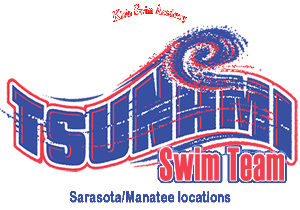How old should a child be before they start swimming lessons?
There is no set age, however we recommend all parents and caregivers begin the swimming process soon after a child is born, 1-2 weeks old. The earlier a child is introduced to water the less chance they have of developing aqua phobia.
What age can a child swim by themselves?
This question needs you to define what you mean by swimming. If you mean “Dog Paddling” without proper breath exchange, children as young as 2 years can paddle 12 feet. If you mean Freestyle, we have children under the age of 3 swimming Beginner Freestyle, Breast Stroke and Backstroke with controlled breathing for 60 feet. Sarasota Swim Academy does not teach holding breath or Doggy paddle.
I have never learned to swim myself, how can I teach a child if I can't do it?
You do not need to swim to be able to teach swimming. Some of our best teachers over the years have been non-swimmers. As long as you are comfortable in the pool, and able to stand with your head above the water and move around freely, you can communicate with the child and show them the correct actions and give appropriate support.
When should I feel confident leaving my child in a pool on their own?
Never! Accidents can happen around pools all the time, even to great swimmers. Parents and caregivers should always supervise children.
My child is scared of water and will not get into a pool, what should I do?
Every child is different and there are many forms of fear or as we prefer to call it, a healthy caution. In general this needs to be addressed over time. We have found that the majority of children respond well when they witness other children enjoying water. This needs to be complemented with consistent, positive sessions in the pool where effort is rewarded and confidence is built.
If my child is scared should I just wait until they get older to start swimming lessons?
In most cases No. Often the fear becomes more entrenched the older the child gets. They will simply avoid water for the rest of their lives. Addressing the problem properly with a strategy will not only get them swimming, but teach them the invaluable life lesson that difficult tasks can be overcome with hard work and patience. This does not mean forcing your child to swim. It means gradually getting them used to being in and around water, then using the correct step-by-step swim techniques to build confidence. They will also thank you next time a friend has a pool party.
Are flotation devices (floaties) a good idea for children learning to swim?
It depends on the flotation device. Sarasota Swim Academy feels anything that encourages an upright (vertical) body position only slows down the learning process, hence is a negative. WE DO NOT SUPPORT FLOATIES OR NON-USA COAST GUARD SWIM VESTS.Children need to learn the habit of placing their eyes into the water, creating a horizontal body position when swimming from where they can propel themselves to safety. Flotation devices can be great fun, however we caution against using them every time your child swims to the point where they depend on them. We feel that noodles are a very positive tool to assist with swimming skills.
When should I use goggles, or should I leave them off?
To speed up the learning process, Sarasota Swim Academy advises the use of goggles when teaching new or challenging swimming skills. Goggles stop eyes getting irritated allowing the child to swim longer and in comfort. The goggles also relax the child due to the ability to see where they are going, with targets becoming clearer. However for safety, children must learn to swim without goggles also. We recommend removing the goggles from time to time and see if children can perform the activities without them. Another good rule is to use goggles in lessons, and take them off in free time.
Why can some kids swim well while others struggle?
Everyone is born with varying abilities. Some of the things which influence swimming ability include:
Coordination, Strength, Bone density (buoyancy), Balance, Relaxation, Fine motor skills, History or past experience in and around water.
INFANTS REQUIRE WARM WATER TEMPERATURE of 83+F.
There should not be more than a 3-5 degrees F. difference between air and water temperature
HYPONATREMIA: Infants will drink the water. Too much consumed water is extremely dangerous, convulsions & death are possible, we need to be conservative & follow this “no more than 5 for 5 rule”. NO more than 5 times/5 seconds submersions within a 24 hour period, when child is not yet controlling their breathing.








